Interview with artist Patrick Fleming
Patrick Fleming is a painter and sculptor and craftsman living in Roland, Arkansas. Originally from Illinois, it was the beauty of Arkansas that pulled him here nearly 10 years ago. His vivid paintings and expressive sculptures are inspired by the duality of nature and the conflicts between reason and passion. Patrick’s work is exhibited widely across Arkansas and the US. More of his work can be view at his website fleming-fine-arts.com.
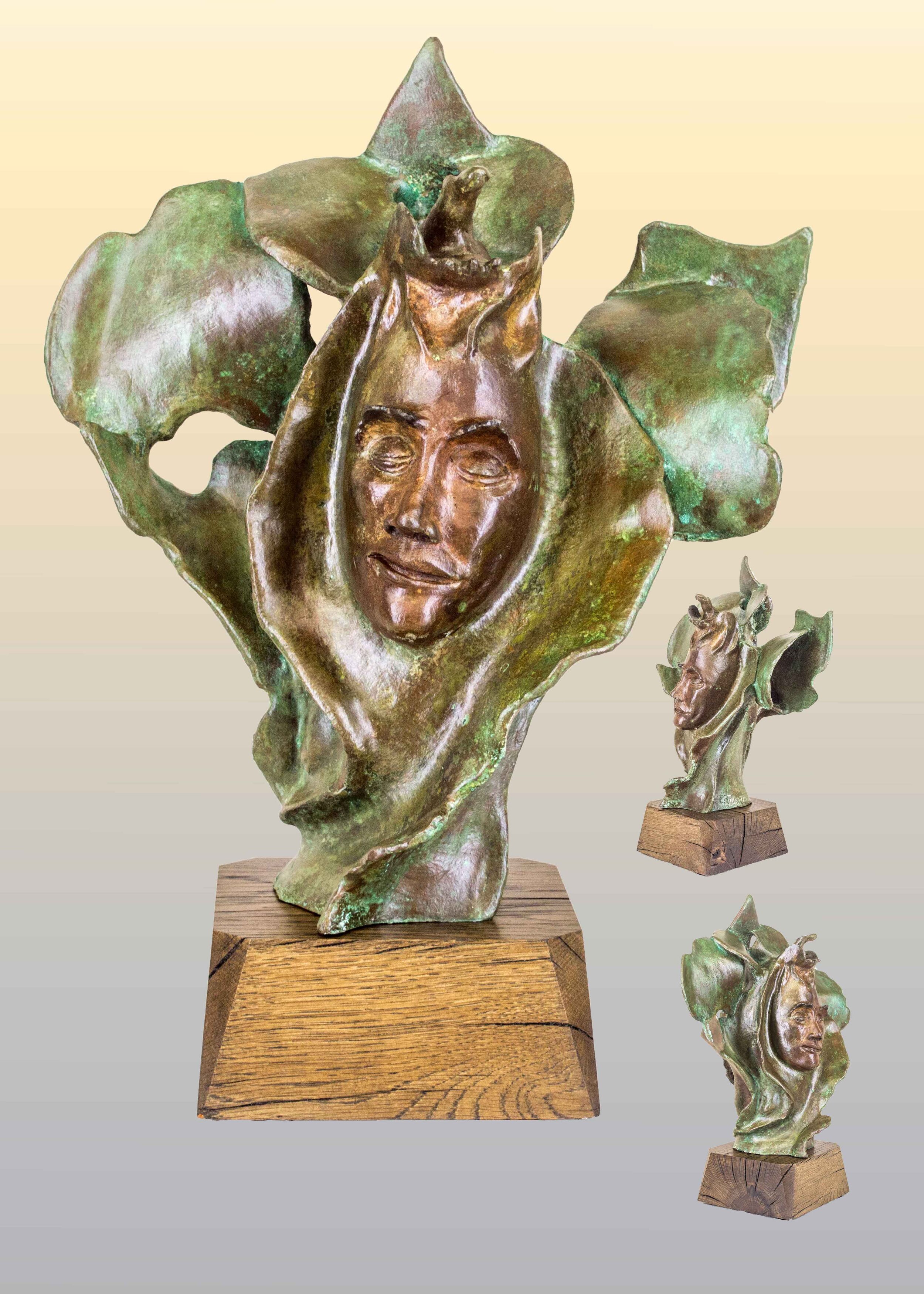


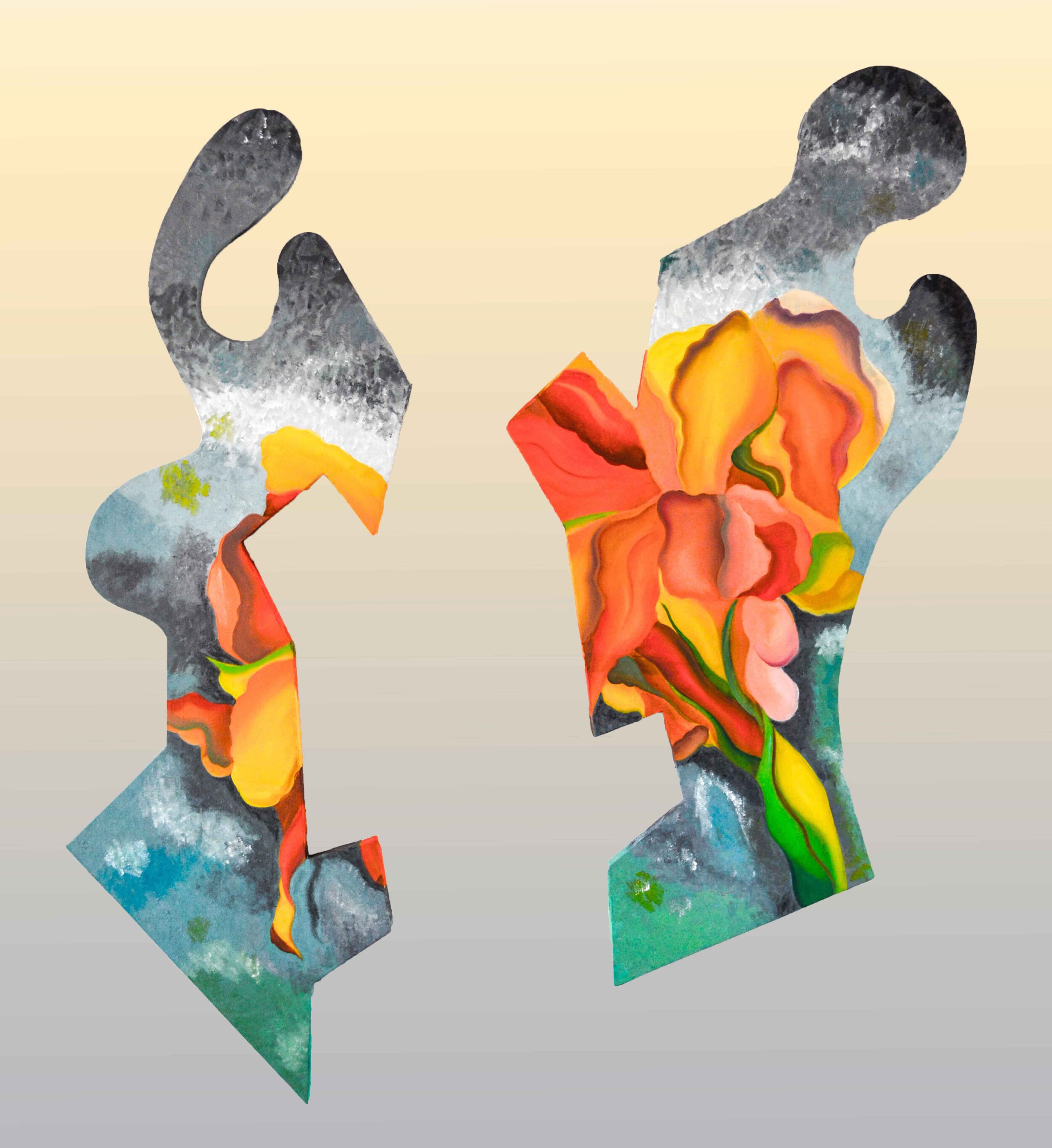
AAS: Patrick, what brought you to Roland, Arkansas from Calumet City, Illinois?
PF: First, I would like to say thank you for allowing me this opportunity to speak about my art. It’s very much appreciated. I’m an avid motorcyclist and I would average 30,000 miles a year on my bikes with Arkansas being one of my favorite destinations. I also worked in Point of Purchase advertising and Arkansas is the home headquarters of a major client I worked with on projects. I fell in love with the area, the geography, and the Southern hospitality. Plus, after living in the Chicago and Milwaukee area most of my life, I just didn’t want to continue living in the cold weather. I enjoy the warmer temperatures of Arkansas. After life changing events I decided to leave my job in advertising and take a leap of faith to work on my passion…art. I figured I would rather work on something that brings me joy and satisfaction than wonder what might happen as I age and didn’t take a crack at continuing to evolve at my art.
I didn’t know anyone here in Arkansas, but I am one to always work and live outside a comfort zone. I retired early from my job, gave away my furniture for two bottles of wine, loaded my motorcycles, personal belongings, and art supplies and drove south to Arkansas. There’s an expression I’ve heard years ago, “If you aren’t living life on the edge, you are taking up too much room”. I now create art in a 3,600 sq ft studio in Roland which is also where I live.
AAS: You also served in the Navy. Was that when you learned your fabrication skills?
PF: In the Navy I was an electronics technician stationed in the Philippines for most of my active duty. We did ship to shore communications and communications from Viet Nam to the US using UHF, VHF, microwave and friend or foe radar for the fighter pilots. My mechanical aptitude is basically self-taught. I learned by reading, observing, taking anything mechanical apart (from waffle irons to automobiles) and rebuilding them again. It was trial and error and experience from ‘the doing’. I also worked as an automobile mechanic during high school for gas stations and automotive repair garages. My father was a mechanic and taught me practical aspects all while allowing me to learn from my mistakes. I have never been afraid to experiment and try something new. I also was never intimidated with making a mistake. Some of the most expensive mistakes are the best learning experiences because you never repeat them. Learning the fabrication of substrates, plastic, sheet metal, wood, vacuum forming, injection molding, tool and die, extrusion, printing, and silk screening came from working in the point of purchase field. The early experience associated with my mechanical background in addition to the fabrication knowledge of working with various substrates is all incorporated into many pieces of my artwork.
“Some of the most expensive mistakes are the best learning experiences because you never repeat them.”
AAS: How did you get started as a model maker and production designer?
PF: After the Navy, I attended Loyola and received my BA in Studio Art with sculpture and painting as my majors. After receiving my art degree, because I also knew how to weld and silver solder I worked as a pipe fitter for Amtrak. My welding and silver soldering experience was essential to earning a living right after graduation. As with many college grads I needed the cash, and the job gave me some breathing room. While working at this job I kept my eyes open for something that was more creative where I could utilize my art background. I found it when a position as a model maker for a display company in Chicago became available. It was between me and two other applicants, both of whom had years of experience in the field. I didn’t give myself much of a chance. However, while touring the model shop and seeing the poor condition of the tools and machinery, I stated that I could rebuild the vacuum former, replace the bearings, and recalibrate the table saw, change the belts on the wood lathe and maintain the many other pieces of equipment. I left that interview without much hope and continued to keep looking for something more creative. A few weeks later I was called back for a second interview. When questioned if I was serious about maintaining the machinery I answered with a resounding and very confident, “yes”. I was offered the job and asked when I could start. That was the beginning of my profession in Point of Purchase advertising. I worked for 35 years, moving from model maker, to designer, into sales and production. This profession allowed me to not only use my mechanical and fabrication expertise, but also allowed me to incorporate aspects of my creative and artistic ability.
During this time, I was raising two daughters and the profession met my financial needs. I was using my creativity in one sense, but it wasn’t feeding my soul. I didn’t work on my own art for over 20 years. Once my daughters reached a certain age I started to paint again. I entered a few exhibits and won some awards and the occasional commissions. I decided it was time to take that a leap of faith and follow my dream. Right here in Arkansas.
“As I create, I reflect about the duality of free will within us all – love and hate, vice and value.”
AAS: When did you begin working in bronze? You have collaborated with several notable sculptors like Michael Warrick and Kevin Kresse.
Patrick with Andy Huss (left) and Michael Warrick (center) installing Mockingbird Tree.
PF: While at Loyola in the late 70’s I had a sculptor professor that took a liking to me, Bill Wichlenski. Loyola was noted for law and medicine and I originally was there to become a psychologist. Obviously, that never happened and is a story for another time. Anyway, Bill allowed me to use his personal studio due to the lack of tools, space, and machinery at Loyola during that time. Because I began at Loyola after my discharge from the Navy, I was a few years older than most students, but close to Bill’s age. We became friends as much as instructor/student. He introduced me to a sculptor from Italy, Mario Spampinato. Mario had learned to cast lost wax using the old-world way used in Italy and Europe. I worked for Mario for $0.50/hour and learned from this master. We would cast for the Art Institute of Chicago and do original reproductions of Remington’s and various other sculptors for the local galleries. When time permitted, I would work and cast my own bronze pieces. I still have them today. Because I wasn’t rolling in cash, I would walk the alleys of Chicago looking for old bronze plumbing fixtures which is how I obtained the bronze to do the casting.
I met Michael Warrick when I moved to Arkansas through a serendipitous moment during an Easter event about a year after I moved down here. As we talked, he discovered I had cast bronze and he invited me to the foundry at the University of Arkansas Little Rock for a pouring. I signed up for a sculpture class with him for obvious selfish reasons, so I could cast my art. Once I proved myself, we became friends. I have helped Michael with various public pieces including the Mockingbird Tree on Chenal Parkway, and the Louisiana Purchase project in front of the convention center downtown just to name a few. Aaron Hussey is another sculptor that I was introduced to via Michael. He was also involved with the Louisiana Purchase project, and he and I have become friends, and collaborated and tossed around ideas.
Patrick with Kevin Kresse working on General Darby.
Michael also introduced me to Kevin Kresse, and we became friends. Kevin was under a deadline for a public commission of General Darby on an old Harley Davidson for Fort Smith and asked if I could help him. Serving time in the military and being an avid motorcyclist, he gave me the freedom to carve on what I knew – the Harley and the M1-Garand rifle and the M1911 .45 caliber pistol (see photo).
AAS: You also do restoration. Is all of that done at your home studio?
PF: Yes, I do these at the studio in Roland. The restoration knowledge comes from working with Mario and Bill while learning bronze casting. Certain galleries would acquire bronzes from Mexico and various other places and ship them to Chicago. Some castings were poorly done and reach the destination in multiple pieces. We would weld them back together, and clean and match the patinas. Bill also had a friend that did major restorations for the Art Institute of Chicago using egg tempera and other types of paint he used to restore very expensive paintings, painted by Old Masters. I would watch him in amazement with his skill level and have incorporated that knowledge into restorations I have done over the years. Mine are a simpler restoration, much smaller, but with welding, and touch ups to match patinas or paint. My skills as a model maker have taught me how to use various materials to fix and repair certain substrates. I have turned a few restorations down as cost would be more than the piece was worth plus I couldn’t guarantee the results. I always explain this to the client and am honest and upfront with them. I’d love to earn the money from some of these restorations, but my ethical and moral obligation is more important.
The Hand That Feeds Me, bronze, zebra wood and purple heart, 12” x 10” x 10”h
AAS: Let’s talk about your sculptures. You said negative space is a key element of your designs. I think The Hand That Feeds Me is a wonderful example of your work.
PF: My sculptures as with my paintings work with what you don’t see as much as what you do see. As I stated earlier, the original intent was to become a psychologist and I believe some of what I do is based on human behavior and emotions. The void within both my sculptures and my paintings is very much a part of the art and the piece. As I create, I reflect about the duality of free will within us all, love and hate, vice and value. The person viewing my art can place their own ideas and thoughts into it.
Some of my inspiration comes from the tribal mask from native Americans and Africa. I would sit and stare at the exhibits in the Art Institute of Chicago and imagine what Shaman wore what mask and what was its intent. I also would sketch people while riding the EL trains in Chicago, and if they caught me, it was like I stole their soul.
The Hand that Feeds Me is an example of the void within the human psyche. As an example, pride can take over when help is needed. Sometimes after the fact of getting that help there are only certain people that have an awareness from within themselves. Those people come back to repay or help others once they have been given a hand when in need. I never placed the words “Bite”, “Help”, “Kiss” or “Shake’ in front of “The Hand that Feeds Me”. I left it up to the individual to determine what mask they wear. My work has been called sensual, erotic, creepy, thought provoking and spiritual and even akin to three-dimensional Rorschach inkblot test. It is up to the viewer of my artwork to decide.


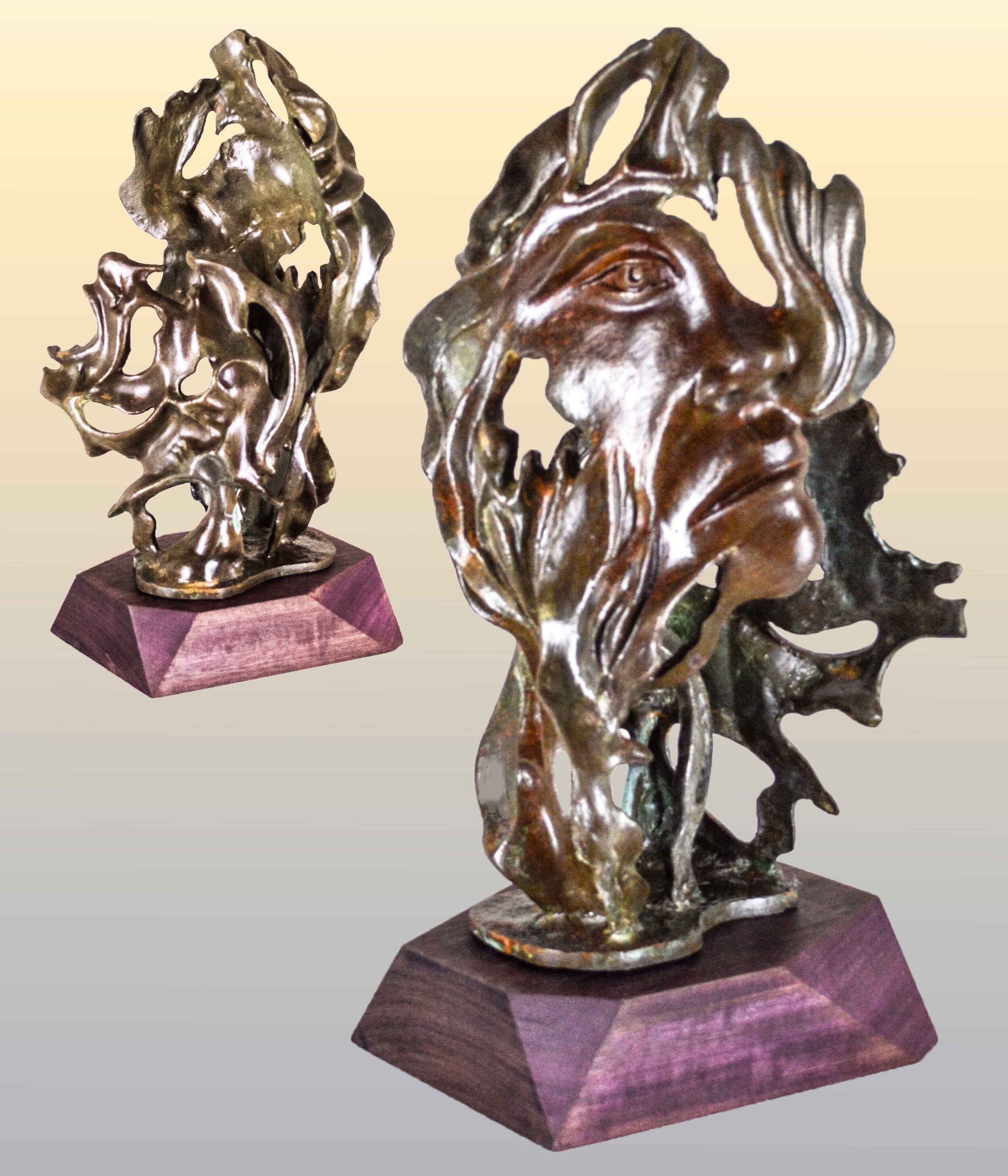
Sandra’s Garden, oil on fabricated canvas, 61” x 54”
AAS: Also utilizing negative space in a unique way is Sandra’s Garden. It was in the 59th Annual Delta Exhibition. What was that experience like?
PF: Sandra’s Garden was one of the first paintings I did when I moved to Arkansas. It’s what people referred to as my puzzle paintings. It’s interesting as to how they want to put it back together when they look at it. Prior to the Delta it was hanging at an exhibit on a brick wall. I had someone come up and tell me they didn’t like the painting because of the brick. I thought it was an odd response and I didn’t have an answer. I couldn’t remove the wall or make it a different material!
Being accepted to the Delta Exhibit was a very humbling experience for me. There was a sense of pride and accomplishment seeing one of my paintings hanging in such a prestigious venue. But as with some artists, there was also a sense of “am I worthy of this?” The negative space within this piece opens a myriad of comments and questions. It pushes the canvas apart and I use color as an emotional element to bring it back together. I paint as one large canvas while it’s together, then separate it to paint the edges. It’s always a surprise to me when finished what it portrays with the void.
AAS: Sandra’s Garden was also in the exhibition “Art That Lifts Our Spirits”, where you were an Award of Excellence winner. You have written that your inspiration comes from primitive art, the duality of human nature and eastern philosophy. Would you talk more about that?
PF: The exhibit was an international virtual exhibit. The painting has a mind of its own and also has some mileage on it as it was also exhibited at the South Arkansas Art Center in El Dorado, Arkansas.
As for the eastern philosophy, I was raised Catholic but fell away from all religion while I served in the Navy. Loyola required twelve hours of theology, so I touched on and studied other major religions of the world instead of Christianity. That brought me to meditation, Buddhism, and the Tao. So, in conjunction with Charles Baudelaire, the African & Native American mask and my limited formal studies in psychology, add Eastern philosophy and place it all in a blender. That’s my art.
AAS: You do a lot of fabricated canvases and frames. Would you talk about that and your piece Sandra’s Garden III?
Sandra’s Garden III, oil on fabricated canvas and walnut frame, 57” x 35”
PF: I’ve seemed to never be satisfied with the status quo. I have many hours of figure study. I have painted, figures, landscapes, still life and multiple portraits. These I consider representational art. I had art professors at Loyola who told me my strong point was in the three-dimensional realm. These dimensional fabricated canvases are something that I’ve had bouncing around in my brain since the late 70’s. Working with the positive and negative space I wanted the painting to continue into the surrounding area. I want the voids to be as inspiring as the art itself. The influence with the flowers comes from Charles Baudelaire’s book of poems, “Flowers of Evil”. How can something so beautiful be evil? Think of the poppy. The poppy is an exquisite and delicate flower, but also opioids are derived from it.
Sandra’s Garden III is the third painting in a series. The first two are fabricated as puzzle pieces that are separated on the wall allowing the void to become part of the painting. For Sandra’s Garden III I took it a step further by eliminating the puzzle aspect and having the frame work as the negative space. I then went even further by fabricating canvases with additional dimensions. The mechanics of the fabricated canvases are from my knowledge in working in advertising and the knowledge of incorporating all the dissimilar materials. It took a few years to develop how the canvas would follow the forms as there’s an issue with the coefficient of expansion between the substrates and adhesives while fabricating the dimensional canvas. But I recently figured it out over time with trial and error. The process is complex and labor intensive allowing the piece to be dimensional in all areas of the X, Y, Z axis. The other creative aspect that must be incorporated is painting the canvas because of the dimensions of the canvas. It tricks the eye, and the perspective or balance becomes a challenge while painting. I must be careful with shadows and painted dimensions where the canvas has a dimension of its own. I initially do a sketch on the canvas for balance and then begin to add color for emotion. The name Sandra’s Garden comes from my first neighbor here in Arkansas; she had a beautiful flower garden that inspired this painting.
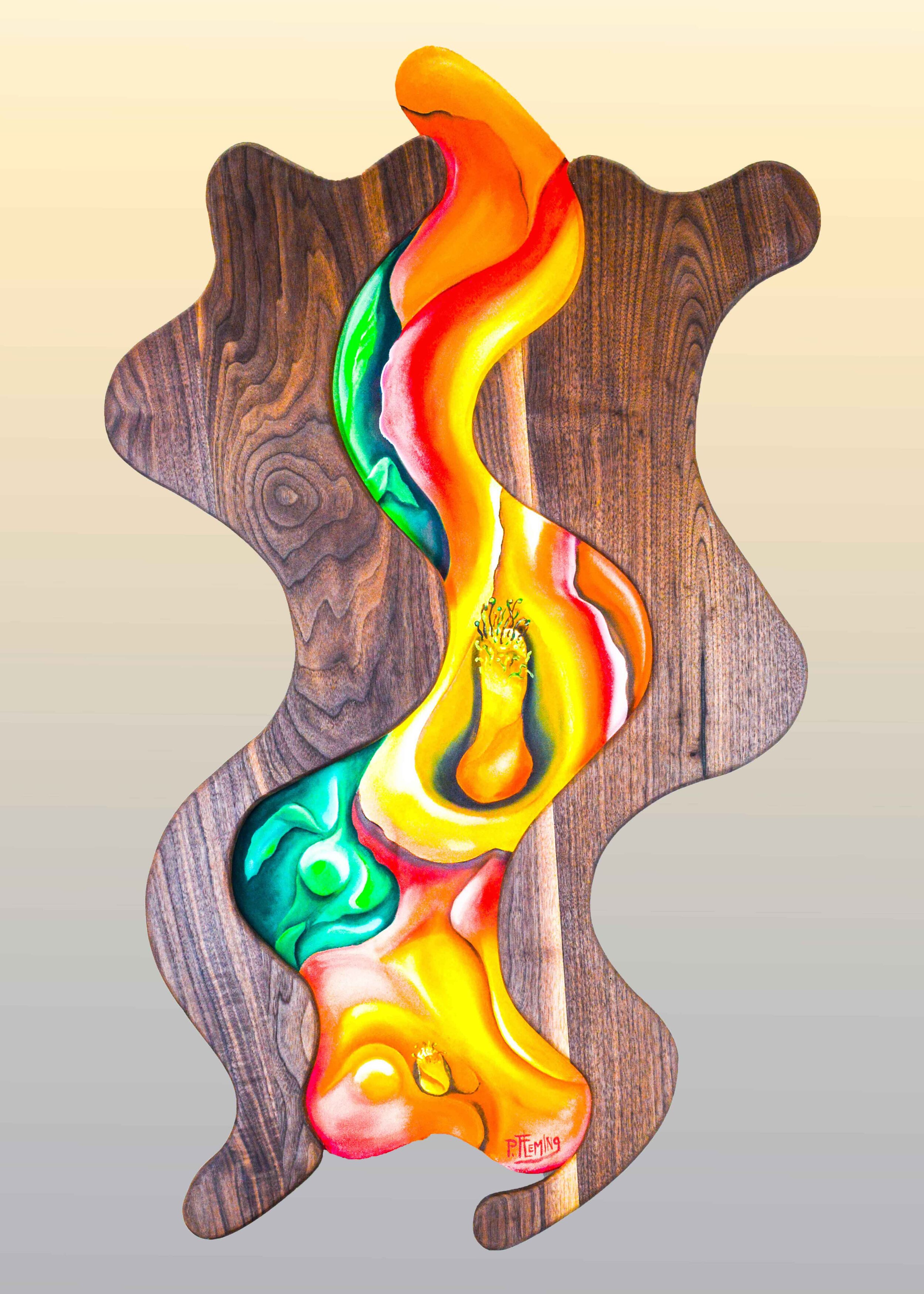
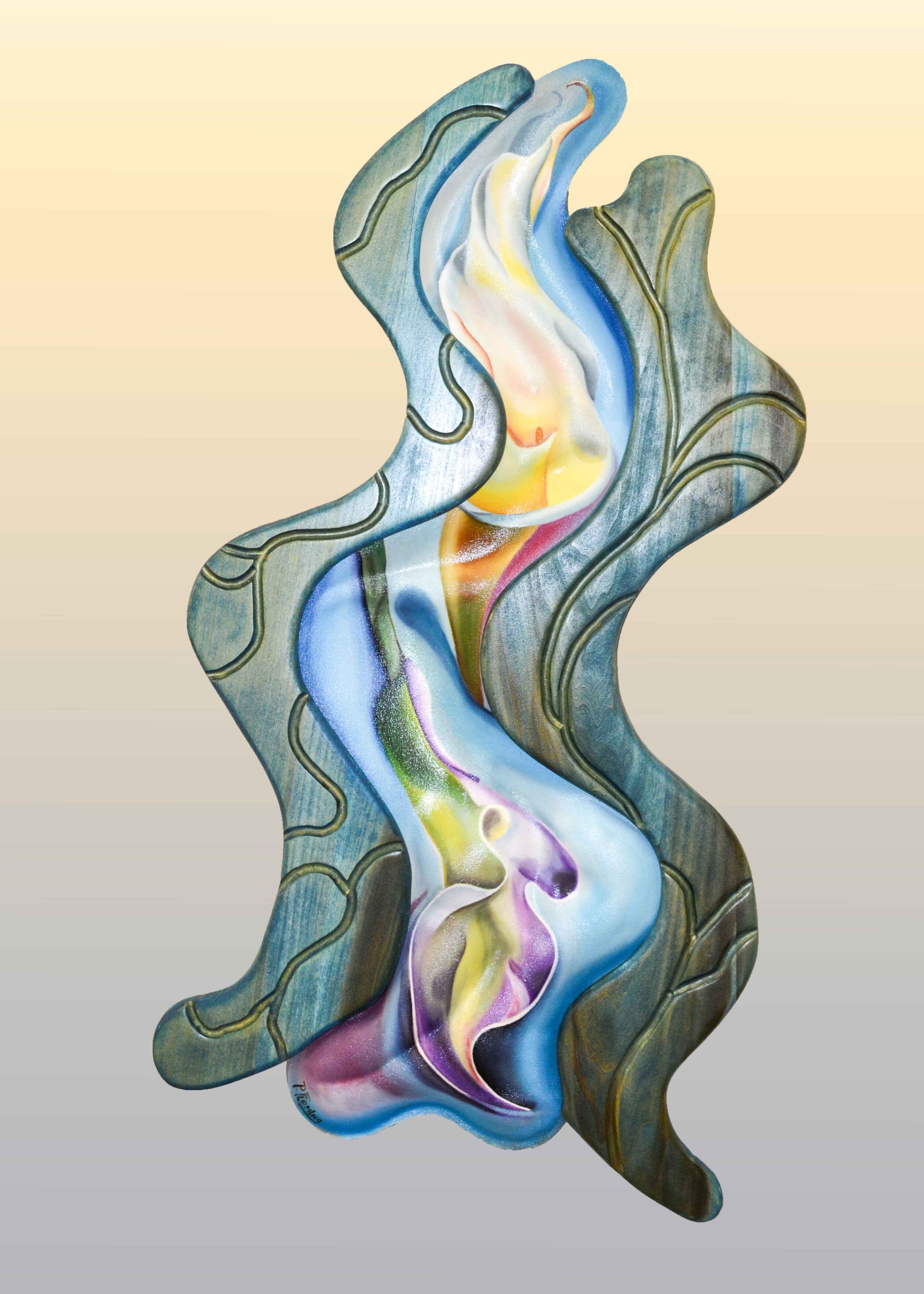
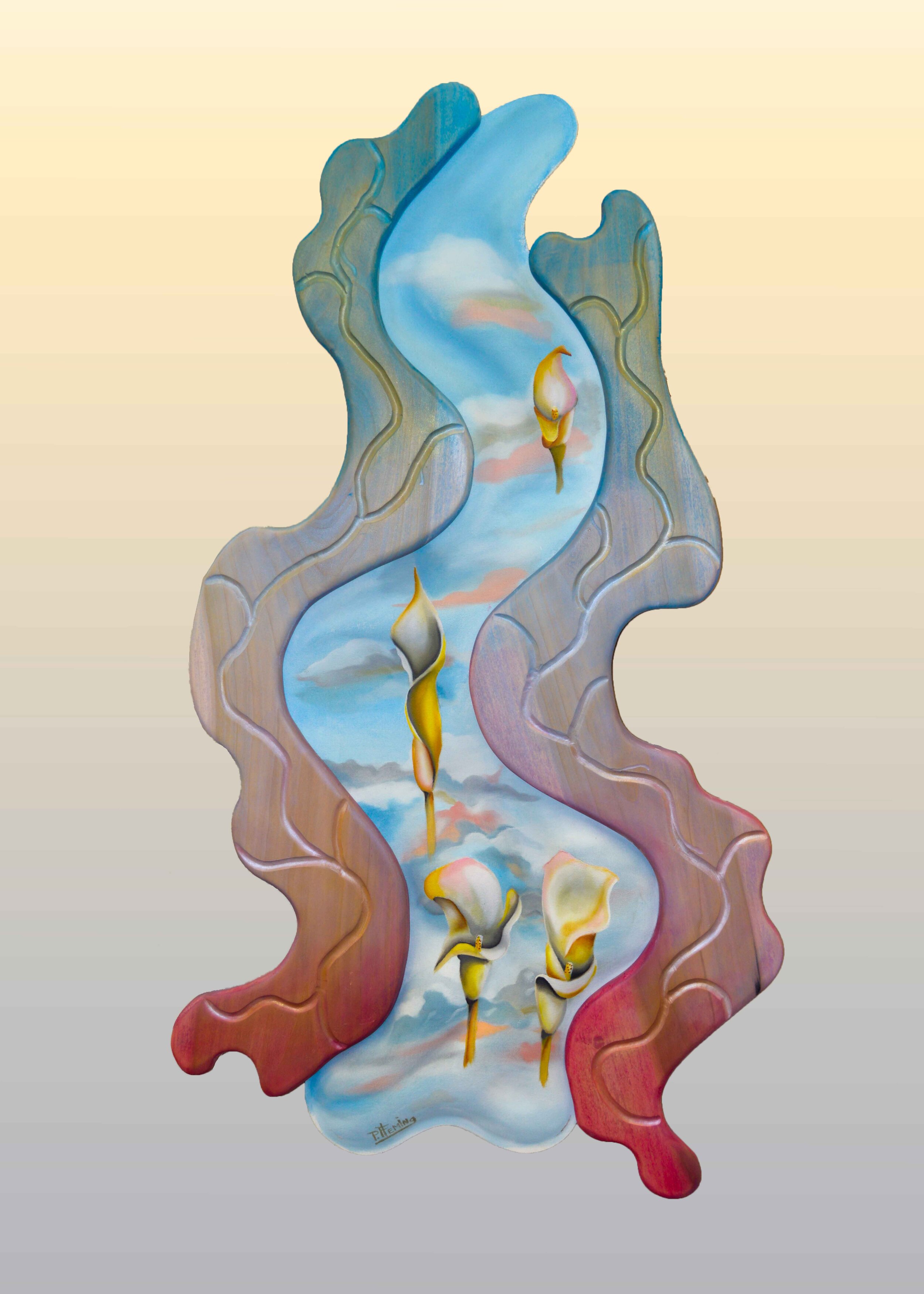
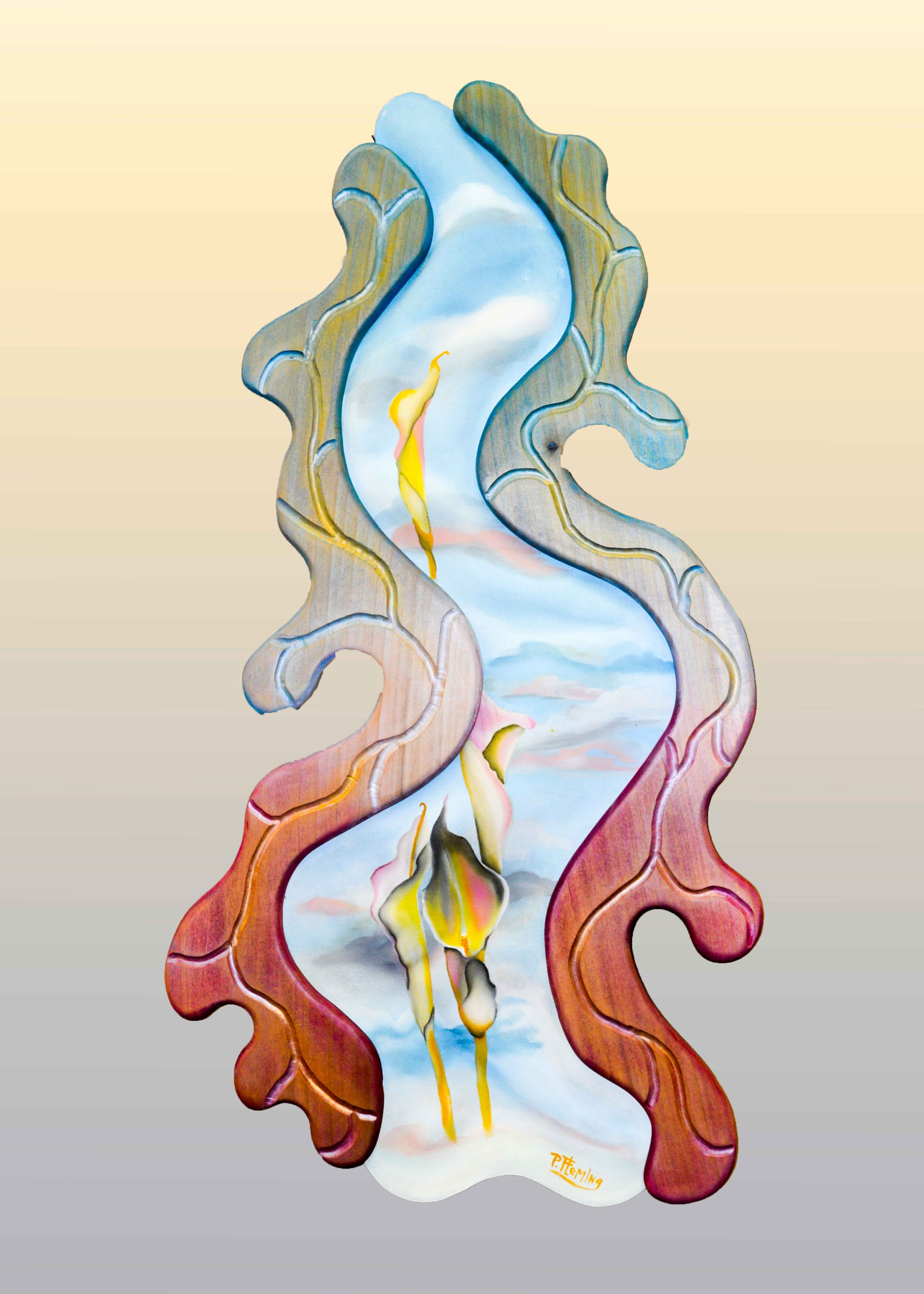
Coffee Table, pecan wood with bronze legs.
AAS: You recently completed a wonderful table. Is furniture something you are doing more of?
PF: This was the first time I have made a significant piece of furniture that is a piece of art. This coffee table was a commission for a friend who is also a patron having purchased sculptures and a painting from me. She had a pecan slab and asked me if I could fabricate a coffee table using the slab. The cast bronze legs were the suggestion of my girlfriend after we discussed what would be not only functional, but also creative, and original. I took English Ivy roots I had laying around the studio to fabricate the legs. I then cast them in bronze and finished them with the green/brown patina. Using a wood planer, I made the pecan slab parallel. I then sanded and applied multiple coats of epoxy. I attached the bronze legs resulting in an organic piece. There has been quite a bit of interest in this coffee table. The comments I have received on this coffee table is that it is a piece of art.
AAS: Thank you for the interview, Patrick.
PF: Philip, thank you once again for inviting me to participate in the forum. This has been enjoyable, and I do appreciate it.


